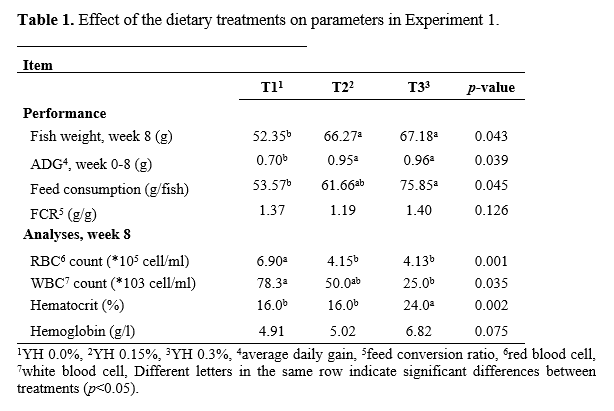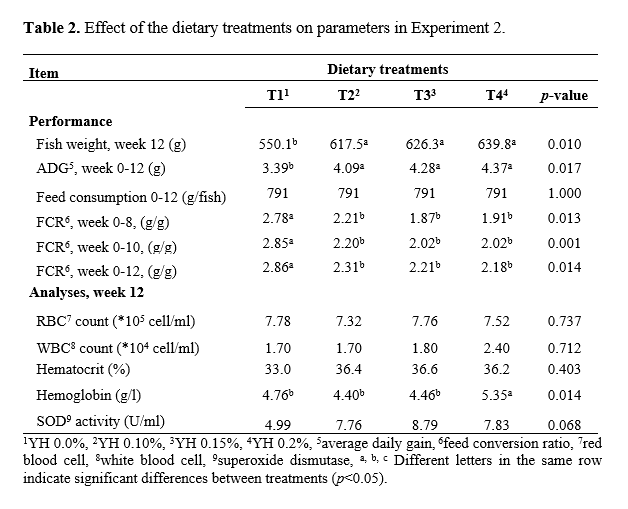DIETARY YEAST HYDROLYSATE IMPROVED THE PERFORMANCE OF JUVENILE AND GROWER ASIAN SEABASS Lates calcarifer
Introduction
Asian seabass (Lates calcarifer) is an omnivorous, euryhaline fish with commercial importance especially in Southeast Asian aquaculture. The performance of Asian seabass is often decreased by pathogenic bacteria, such as Vibrio spp. or Aeromonas spp. Dietary strategies to improve fish performance are needed. The present study investigated the effects of dietary Saccharomyces yeast hydrolysate (YH) on the performance of juvenile and grower stage Asian seabass which were grown in earth ponds in Thailand.
Materials and methods
Two experiments were conducted: E1 for juvenile fish, with a mean body weight 13g on day 1, and E2 for the grower stage, with a mean body weight 270 g on day 1. Both experiments were carried out in net cages, in earth ponds of 0-3 ppt saline water, which was aerated to maintain DO>5 mg/l. Commercial-type feed for Asian seabass was amended with different levels of YH (Progut® Extra, Hankkija Oy, Finland) for the dietary treatments. The set-up for E1 was 30 fish/cage, density of 15 fish/m3, 3 treatments with YH levels of 0.0, 0.15, or 0.30%, 4 pens/tr, and a trial period of 8 weeks. In E2 there were 10 fish/cage, density of 5 fish/m3, 4 treatments with YH levels of 0.0, 0.10, 0.15, or 0.20%, 5 replicates/tr., and trial period of 12 weeks. In both experiments, the fish were fed three times a day at 3-5% of body weight. Remaining feed was siphoned out, dried and weighed for calculating feed intake. Fish weight gain and feed conversion ratio (FCR) were recorded every two weeks. On the final day, blood samples were collected for the analysis of white and red blood cell counts, hemoglobin, hematocrit, immunoglobulin M (IgM), lysozyme activity, and glutathione. Foregut villus length was measured from histological samples. In E2, superoxide dismutase (SOD) activity was measured from blood samples, and the carcass composition was determined. Study design was completely randomized in both experiments, and one-way ANOVA and Duncan’s Multiple Range Test were used for data analysis. Limit for statistical significance was set to p<0.05.
Results
In E1 (Table 1), dietary YH significantly increased average daily gain, fish weight on the final day, and feed intake. Feed conversion and mortality were similar in all treatments. Hematocrit was increased by YH, while YH significantly decreased the red and white blood cell counts. The treatments did not significantly affect serum protein concentration, immunoglobulin M, glycogen, lysosome activity, glutathione, or foregut villus length.
In E2 (Table 2), YH significantly and dose-dependently improved the average daily gain, and also increased fish weight at 12 week. Feed conversion was significantly improved by dietary YH amendment. Mortality was 0% in all treatments throughout the experiment. Hematocrit, serum protein concentration, mean villus length, lysozyme activity and glutathione were all unaffected by the dietary treatments. The SOD activity tended to be higher for YH-treated groups than the control group (p=0.068). Carcass composition and foregut villus length were not affected by the dietary treatments.
Discussion and conclusions
In conclusion, dietary YH supplementation had a positive effect on the weight gain and final weight of juvenile and grower Asian seabass. Feed conversion was improved by dietary YH in the grower age group. Dietary YH may be a strategy for improving the performance of Asian seabass. Immunological or physiological mechanisms behind the observed performance effects remained inconclusive, and open for further studies.


